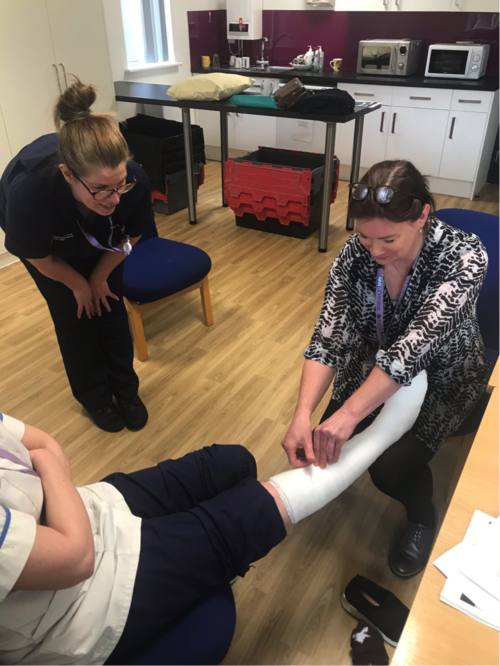Manchester Leg Circulation Service : “our redeployment story”
Sue Matthews and Martin Fox, Vascular Specialist Podiatrists at MLCO, share their redeployment story.
“This crisis has enabled more interdisciplinary team working and the development of relationships with other colleagues and a greater appreciation of what we all can offer our patients.
Since the Covid-19 pandemic, the MLCO Podiatry-led Leg Circulation Service has been reduced from providing a 5 day week peripheral vascular assessment, diagnosis and triage service to one day per week plus telephone triage.

We are undertaking many more telephone triage consultations to ascertain if patients have any urgent problems, for example wounds to the lower limb or symptoms suggestive of deteriorating claudication or ischaemic rest pain. Patients with suspected critical limb ischaemia, chronic limb threatening ischaemia or severe peripheral arterial disease (PAD) are still offered face to face appointments but we are no longer offering any other routine appointments at this time.
We are working closely with GPs, other community lower limb provider services and the secondary care vascular teams at Manchester Royal Infirmary and Royal Oldham Hospital, who have also issued guidance to restrict referrals to critical or imminently limb threatening ischaemia only. Because of the situation we find ourselves in we are using communication technologies to allow remote consultations with our secondary care vascular team colleagues when we have urgent concerns about limbs or lives.
By doing this we have managed to avoid unnecessary hospital visits for patients where they are not essential, as well as ensuring those people with ischaemia red flags are still urgently seen or provided with appropriate advice via teleconsultation.
Because of the coronavirus situation, the hospital vascular teams are only able to see those who have an imminent limb threatening condition due to severe ischaemia and / or sepsis. They are now undertaking angioplasties and trying to avoid by-passes to reduce the burden on critical care beds.
We have worked with our local vascular teams and a collaborative group of expert clinicians from Foot in Diabetes UK (FDUK) to develop brief guidance to support all lower limb clinicians during the COVID-19 situation in line with best practice.
The aim is to assist the identification and management of people with critical / limb threatening ischaemia or severe infection and focus clinical assessment and decisions on urgent triage, referrals and access to High Risk Foot Podiatry, Hospital Vascular, Diabetes Foot, Infectious diseases or Orthopaedic / Podiatric Surgeon teams for potential life and limb saving treatments.
We have been deployed to support our community integrated care teams. We are undertaking lower limb arterial assessments of patients with wounds and working with our District Nursing, Lymphedema and Tissue Viability Nurses to optimise assessments and treatment plans for often complex or very vulnerable patients, which has included considering commencing full or reduced compression therapy for some patients and red flag ischaemia detection in others.

We have been learning a lot from our colleagues about wound care, compression therapy, sepsis and pressure area assessment and we have been able to support our District Nurse and other lower limb colleagues to develop their arterial assessment skills, and breakdown barriers that can prevent this happening in a timely way.
For example, there is misconception that it takes 2 people and one hour to carry out an ABPI, which can result in the important diagnostic assessment being delayed or not happening. Demonstrating 15 – 30 minute foot to femoral Doppler’s + ABPIs in complex home care settings has been a game-changer with colleagues who can see how they could be doing this routinely within their caseloads, where it would add value or confidence to patient management decision.
Many patients with oedematous legs are unable to tolerate ankle pressures easily. We have been able to support assessment using toe pressures and TBPI and demonstrate how this assessment can be done in around 15 minutes once the skill has been learned. We are now discussing and planning brief vascular skills training sessions with our community and treatment room nursing teams.
In the ‘new normal’ that will arise from the COVID 19 situation, we have the opportunity to change some of the ways that we work to improve both current and future clinical service provision. This may include undertaking more telephone reviews and triage and more interdisciplinary working in
community as well as hospital settings.
We are developing an increased appreciation of what each profession can offer for better collaboration and patient outcomes.
The use of technology and new pathways and access for remote consultations between podiatry and vascular teams can only save time and money in the future, whilst maintaining safe quality care and improving the patient journey. Improving lives and saving limbs is a goal we can all sign up to, using our COVID experience to help design.”
